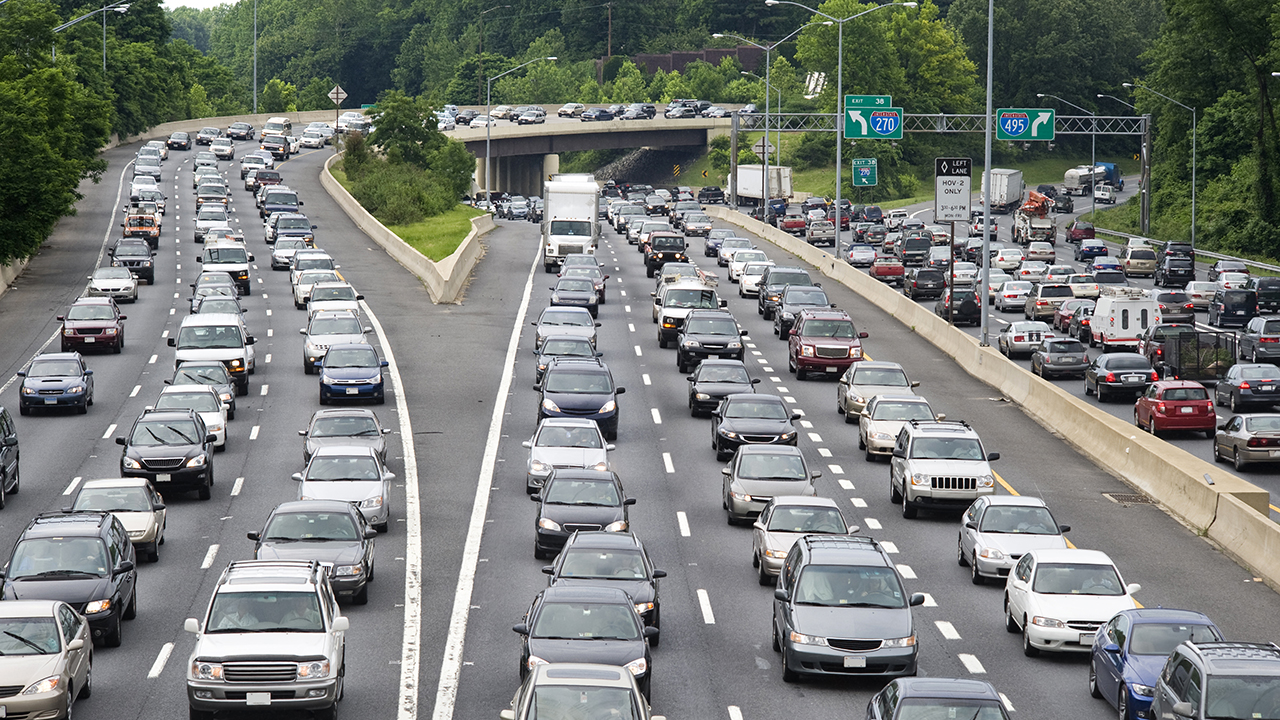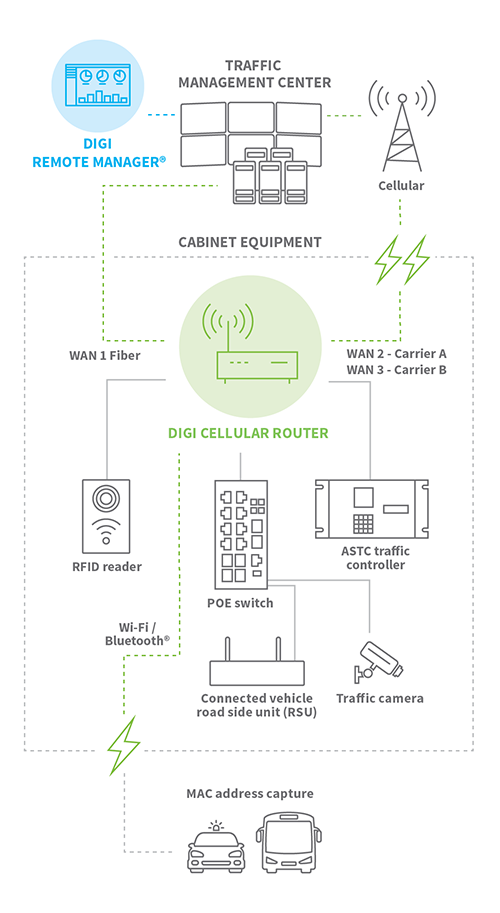Smart Traffic Management Systems are technology solutions that municipalities can integrate into their traffic cabinets and intersections today for fast, cost-effective improvements in safety and traffic flow on their city streets. What's more, deploying these systems today, or upgrading your city's existing Intelligent Transportation Systems (ITS) infrastructure can create huge efficiencies and cost savings, while massively improving system reliability, all of which have excellent ROI.
These systems utilize sensors, cameras, cellular routers and automation to monitor and automatically direct traffic and reduce congestion. The right technology solution can be scaled to any size and painlessly upgraded at any time. Simultaneously, these technology solutions prepare Smart Cities for coming technology evolutions, including Connected Vehicle and the full deployment of 5G networks.
Why Evaluate Smart Traffic Technology?

Budgets for public infrastructure are always tight, and constructing roads and bridges is always expensive. Smart Traffic Management Systems help municipal and regional transportation departments to cope with the situation — quickly and cost-effectively. Integrating smart traffic technology helps them affordably get better performance from their existing infrastructure.
Let's explore how augmenting and retrofitting infrastructure can dramatically improve the efficiency and safety of existing traffic networks.
Smart Traffic Management: Smart Cities Do More With Less
The problems plaguing our streets and highways are well known. Traffic slow-downs can cause debilitating congestion and add to urban air pollution. Businesses suffer from delivery delays and lost productivity. Emergency vehicles are slowed down by bottlenecks, potentially putting lives at risk. And all of it diminishes the city's overall quality of life.
Meanwhile, cities and regional governments continually ask their traffic management teams, civil engineers and highway maintenance crews to do more with less. In the face of these challenges, innovative cities — "Smart Cities" — are using a coordinated array of hardware, software and cloud solutions to increase traffic flow and improve safety. Smart Traffic Management Systems, which are included in the umbrella of “intelligent transportation systems” and sometimes called “intelligent traffic management,” are automated systems that incorporate the latest advances in Internet of Things (IoT) technology.
These systems can optimize traffic flow and enhance safety by using sensors, cameras, routers and cellular technology to dynamically adjust control mechanisms such as traffic lights, freeway on-ramp meters, bus rapid transit lanes, highway message boards and even speed limits.

Today, Smart Traffic Management Systems make it possible to increase the capacity of city streets without actually adding new roads. With the advent of connected vehicle technology, these systems will also be able to directly control vehicles when needed — braking them in intersections, for example, to prevent accidents with pedestrians or other vehicles. Smart Cities are deploying these systems now to be prepared when the vehicle technology is fully tested and deployed.
The Enabling Technology Behind Smart Traffic Management
All of this connectivity requires sophisticated hardware and software. Digi offers secure, scalable, high-speed connectivity to address the range of traffic management requirements. Designed to operate optimally regardless of moisture, vibration and temperature extremes, Digi industrial and transit routers are installed in Smart Cities around the world.
Some of the key functionality cities achieve with these systems include the following:
- Congestion detection: With cameras and sensors constantly monitoring intersections, technicians can monitor the entire city from the city's traffic management center.
- Adaptive control: Congestion detection also enables adaptive control, which causes dynamic adjustments to systems including traffic lights, on-ramp signaling, and bus rapid transit lanes.
- Connected vehicle: This up-and-coming technology enables vehicles to communicate directly with intersections. The Smart Traffic Management can include a connected vehicle roadside unit for this purpose.
- Emergency routing: A critical application of the Smart Traffic Management System is the ability to give priority access to police, fire and ambulance services.
 All of these functions require monitoring, detection, reliable high-speed data transfer and automation. One purpose-built Digi cellular router can provide the communications backbone to manage all of these systems.
All of these functions require monitoring, detection, reliable high-speed data transfer and automation. One purpose-built Digi cellular router can provide the communications backbone to manage all of these systems.
Examples of Digi's communications solutions for traffic management include the following:
- FirstNet Ready™ Digi TX54 Router for Critical Connectivity
Digi TX54 is a secure, high-performance cellular router that has been approved for use on the FirstNet® communications platform, the high-quality spectrum developed for police, fire, ambulances and other emergency services. Digi WR54 serves as the primary router and workhorse managing communications and providing cellular redundancy to ensure uptime. The Digi WR54 is secure by design, with Digi TrustFence®, a sophisticated suite of integrated hardware and firmware features. Some of the key features include link failover and load balancing across dual 600 Mbps CAT 12 cellular connections, and Ethernet, serial, Wi-Fi and Bluetooth for connecting a range of assets.
- Digi WR31
Digi WR31 is a cellular router that collects data from roadside sensors, traffic controllers and cameras positioned at traffic intersections, highway ramps and other points, and can be deployed in traffic management systems that do not require the full functionality of the Digi WR54. Built to endure the harsh conditions of outdoor cabinet enclosures, Digi WR31 sends data via high-speed 4G LTE links to the traffic management center, where it can be analyzed automatically to optimize traffic flow. Digi TransPort WR31 offers software-defined, multi-carrier networking and drop-in connectivity to help reduce downtime and bring distributed sites online faster. It even sends an alert if a traffic control cabinet is left open or unlocked. The Digi TransPort WR31 is also suitable use with on-site solar panels—reducing cost and increasing deployment flexibility.
- Digi IX14
This rugged, industrial LTE router connects meters and remote sensing equipment to traffic management centers, and is a low-cost system for the most cost-conscious traffic management operations. Digi IX14 is also secured by Digi TrustFence, which protects the router and ensures the reliability and integrity of its security functions. Digi IX14 also includes built-in mechanisms that enable it to be updated and managed remotely.
- Digi Remote Manager — for configuration, remote access and control
The Digi cellular routers in your traffic management network can be quickly configured using Digi Remote Manager®, and then managed remotely from a single platform. This secure, hosted application lets administrators monitor and troubleshoot their systems as well as perform mass configurations or simultaneous software updates. Digi Remote Manager offers a single point of command and control, along with system-wide monitoring that includes dashboards to view performance metrics, and automated alerts for specified conditions and thresholds. Digi Remote Manager can generate reports ranging from daily summaries to detailed period-based metrics. It also helps with the integration of legacy systems into the traffic management network. For example, new devices added to the system can be configured quickly in Digi Remote Manager from saved configurations to either swap out devices or scale up the installation with more devices.
Digi technology solutions integrate with existing traffic management systems to provide critical communications, security, reliability, and device management. Digi also offers professional services to integrate and install the systems and develop applications for specific requirements. With thousands of installations across the U.S., our teams have deep experience in tailoring and installing these systems on tight timelines.
Download our Smart Cities White Paper
Is your city keeping up with new technologies?
Download PDF
Improving Commuter Traffic and Emergency Preparedness
Daily traffic congestion may be one of your city's biggest headaches. Ensuring emergency vehicles can rapidly and effectively reach their destinations is a critical metric of success for any traffic management system as well. In addition to handling these urban challenges, city managers also know that disaster preparedness is critical in the event of city-wide events.
During a large scale public emergency, such as a hurricane, tornado or other major disaster, civilian cell phone use can jam cellular networks, jeopardizing communications with first responders and city leaders.
FirstNet is a U.S. nationwide wireless network designed to provide voice, text and data communications for emergency responders — the primary category of public safety entities —as well as "extended primary" services, which include critical infrastructure such as power grids, commuter rail, and water and sewage systems. Digi is building cellular systems to support smart cities in their critical disaster preparedness planning, such as the FirstNet Ready™ Digi WR54 cellular router. This designation means that it has been tested and certified to meet the strict criteria for devices designed for these critical situations.
Preparing for 5G, Connected Vehicles and More
Techology is always evolving and the future is on the horizon, even as organizations and municipalities make their best choices for infrastructure maintenance and enhancements today. As a technology leader in the networking and IoT space, Digi develops mission critical solutions that are designed for longevity, scalability and evolution to support enterprises and smart cities in long-term planning. For information on the integration of LTE and 5G technologies and networks, and to start your 5G planning, be sure to visit our 5G information page.
Connected vehicle technology is one example of an innovation that will have a huge impact on smart city technology planning. Under trials at test sites, connected vehicle technology will enable vehicle-to-intersection communications and automated braking. As networks become faster, and latency lowers, the ability to make instantaneous, automated decisions for driver and pedestrian safety will increase. Many Smart Cities are integrating the infrastructure techology today to be prepared for connected vehicle at its earliest availability. In the foreseeable future, technologies such as machine learning will also be deployed as it is tested for efficacy in identifying objects and making rapid decisions to improve city safety.
Reducing Congestion Without Widening Roads
In spite of constrained budgets for infrastructure upgrades, Smart Cities around the world are using smart traffic management technologies to improve the overall performance of their traffic networks, with high performance, secure, redundant and reliable communications solutions that can help streets and highways carry more traffic in greater safety.
At Digi, we have teams with deep experience in transit and traffic management, as well as fleet technology, telematics and system integration to support municipalities in making their smartest infrastructure and city management choices. Contact us to start a conversation about smart traffic, transit, and emergency preparedness solutions for your city.